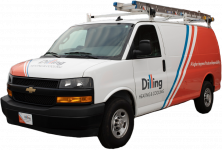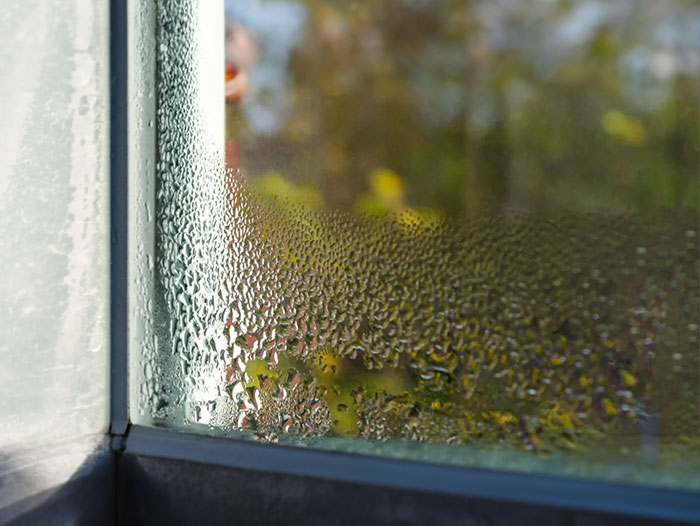High humidity is a problem for residents of Pennsylvania and New Jersey, especially in the summer and even into the early fall. This unwelcome presence can lead to mold growth, poor indoor air quality, wood rot and other issues that make living uncomfortable.
But why is your house so humid?
What can you do about it?
Fortunately, there are several simple steps you can take to reduce humidity levels in your home for good. With just a few changes around the house, you’ll be able to enjoy comfortable temperatures all year round.
What is high humidity?
High humidity is defined as a relative humidity level of over 60%. An atmosphere of high humidity means there is more excess moisture in the air than the air can hold at its current temperature. In extreme cases, an excess humidity level of over 90% can cause condensation on windows and walls.
Excessive moisture in your home can create many problems, and create an environment in which mold (mold spores, and mildew are present and create an indoor air quality problem and health problems for the inhabitants. You must decrease humidity in humid climates, and control moisture, to get these issues under control.
What can Dilling HVAC do to help you with your humidity issues?
The first step to reducing high humidity levels in your home is to check if your HVAC system is operating correctly. The heating, ventilating, and air conditioning system helps create a balanced environment by regulating the temperature and air flow in a house. If the HVAC system isn’t running efficiently, it can cause an increase in humidity levels due to insufficient ventilation or cooling.
What do I need to do to ensure my HVAC system is helping keep humidity low?
To ensure that your HVAC system is working properly, you should have it inspected and serviced regularly by an experienced technician from Dilling HVAC. They can identify any issues with the unit that may be contributing to higher than normal humidity levels in your home. This could include malfunctioning parts such as faulty blower motors or clogged filters. A qualified Dilling technician can also advise you on any necessary repairs or upgrades that could improve the performance of your HVAC system.
What is another step I can take to control humidity?
The second step to reducing humidity levels is to invest in dehumidifying equipment, such as a dehumidifier. Dehumidifiers are effective at removing moisture from the air, thus helping to reduce indoor humidity levels and make your home more comfortable. Homeowners should pay attention to their dehumidifier’s maintenance schedule and clean it regularly so that it continues to work efficiently.
What are some reasons for high humidity in your home?
1. Poor insulation of walls, ceilings and floors
Poor insulation of walls, ceilings, and floors can lead to high humidity in a house because poor insulation makes it easier for warm air from outside to enter the home. This warm air contains higher levels of moisture than the cooler air inside. This moisture then accumulates in the house and increases the overall humidity level.
Poor insulation also affects the performance of your HVAC system as it has to work harder to keep temperatures balanced and reduce the amount of moisture entering through walls, ceilings, and floors. With inadequate insulation, your HVAC system doesn’t have enough time to cycle and dehumidify the indoor air efficiently. This results in a humid environment that is susceptible to mold growth and other problems related to high humidity levels in a home.
2. Leaking pipes or plumbing fixtures in the house
Leaking pipes and plumbing fixtures can be a major source of high humidity levels in your home. Since water is highly hygroscopic, even small amounts of moisture escaping from pipes or fixtures can significantly raise indoor humidity levels.
Leaks can come from a variety of sources, such as cracked toilets, leaking washing machines, and faulty pipe joints. Whenever pipes or fixtures are not properly sealed or maintained, they will allow moisture to enter the environment and create an atmosphere that is prone to condensation and mold growth.
In addition to raising humidity levels in your home, leaking pipes and plumbing fixtures can also lead to water damage in walls or floors. If left unchecked for too long, this can cause rot and structural damage to your house. It is important that any leaks are identified quickly and fixed immediately by a qualified plumber. Repairing these leaks can help reduce indoor humidity levels significantly and prevent future water damage problems.
3. Humid outdoor air entering your house through cracks and gaps around windows and doors
Humid outdoor air entering your house through cracks and gaps around windows and doors can have a negative impact on the indoor environment. Since humid air contains more water molecules than dry air, it is more likely to cause condensation, which in turn leads to mold growth and other forms of damage. This moisture can also seep into walls and floors, causing wood rot and structural damage if left unchecked.
In addition to these physical issues, humid outdoor air that enters a house can also damage electronics located inside – such as TVs, computers, an air conditioner unit, and appliances – due to static electricity buildup. High levels of humidity create an electrostatic discharge which can cause irreparable damage to electronic items.
High humidity levels are also associated with bad indoor air quality. When the relative humidity reaches 70% or higher, dust mites and allergens are able to thrive, leading to increased respiratory problems for people who suffer from asthma or allergies. Not only that but high humidity makes it harder for sweat evaporation as well as body temperature regulation which leads to dehydration and discomfort.
Taking steps to reduce the amount of humid outdoor air entering your home is essential in maintaining a healthy indoor environment. This includes checking for leaks in plumbing fixtures and repairing any cracks or gaps around windows and doors.
Investing in proper insulation systems as well as dehumidifying equipment such as dehumidifiers will help keep your home comfortable year round while reducing potential damages caused by high humidity levels.
4. Faulty HVAC system or lack of cooling in summer months
A Faulty HVAC system or a lack of cooling in the summer months can cause higher levels of humidity inside a home. With a faulty HVAC system, the unit may not be able to evenly regulate temperatures and air flow – leading to stagnant air and increased indoor humidity. The motor bearings and belts in an HVAC unit can also become worn out over time, reducing their effectiveness at cooling or dehumidifying the air. Additionally, if the filter is blocked or clogged with dirt or debris, it could reduce airflow and trap moisture within the home.
In addition, when there is a lack of cooling in summer months, warm humid air from outside can enter the home through leaks or gaps around windows and doors. This warm air brings more moisture into the home, raising indoor humidity levels. Poorly insulated homes are particularly susceptible to this problem as inadequate insulation makes it easier for warm outdoor air to enter and remain inside the house for longer periods of time – thus allowing more moisture build-up in walls and floors.
5. Inadequate ventilation throughout the home
Inadequate ventilation throughout the home can lead to higher humidity levels because without proper ventilation, moisture cannot be released into the atmosphere. This means that moist air gets trapped in the house and builds up over time, leading to higher humidity levels overall. Poor air circulation also prevents fresh air from entering a space, so stale humid air is constantly recirculated within the home instead of being replaced by drier outside air.
Additionally, inadequate ventilation may prevent condensation from evaporating naturally, leading to a buildup of humidity in walls or other enclosed areas of your home.
By improving air circulation with fans or ventilators and opening windows regularly to allow fresh outdoor air into your house once in a while, you can reduce indoor humidity significantly and make your home more comfortable all year round.
6. Improperly sealed vent fans, exhaust ducts or uninsulated attics/crawl spaces
Improperly sealed vent fans, exhaust ducts, or uninsulated attics/crawl spaces can all lead to higher humidity levels in a home. Without proper insulation and sealing, these areas of a house allow humid air to enter from outside and build up over time. This means that moist air gets trapped inside the house rather than being released into the atmosphere, leading to higher indoor humidity levels overall.
In addition to allowing more moisture into a space, uninsulated attics/crawl spaces or improperly sealed vents and ducts can also prevent condensation from evaporating naturally. Since warm air holds more water vapor than cold air, any humid air that enters an attic or crawl space will get trapped in an enclosed area which prevents the condensation from evaporating into the atmosphere. This results in higher concentrations of humidity in walls or other enclosed spaces that leads to mold growth, poor indoor air quality (IAQ), and wood rot.
Furthermore, inadequate ventilation caused by insufficient insulation or improper sealing can lead to stale humid air being constantly recirculated within the home instead of being replaced by fresh outdoor air. This creates an unpleasant situation where stagnant air is continually reduced with no relief through adequate ventilation – increasing indoor humidity levels significantly over time.
By installing proper insulation systems as well as effective ventilation systems such as fans and ventilators, you can reduce indoor humidity significantly while improving IAQ. Additionally, insulating and properly sealing vents and ducts throughout your home will ensure that only clean dry outdoor air enters your house – reducing humidity levels dramatically while preventing future damage caused by high concentrations of moisture in walls or floors.
7. Running a clothes dryer without an adequate venting system to remove humidity from your home’s interior space
Running a clothes dryer without an adequate venting system to remove humidity from your home’s interior space can lead to higher levels of indoor humidity. This is because the hot, moist air created when the clothes are drying will linger in the house if there is no proper ventilation for it to escape. As this warm air circulates around the home, it will carry more moisture with it and eventually settle on walls or floors – leading to higher concentrations of humidity in enclosed areas.
8. Insufficient thermal boundary lets humidity into the house
When a home has an insufficient thermal boundary, it can allow for excessive humid air to enter from outside. This can drastically increase the level of humidity inside the house, making it feel uncomfortable and stuffy. Insufficient insulation in walls, ceilings and floors is often the root cause of this issue. In addition, gaps in windows and doors provide easy access for humid air to infiltrate your home.
How can Dilling HVAC solve your high humidity issues?
High humidity levels cause more than just discomfort – they can result in mold growth, poor indoor air quality and wood rot too. That’s why it’s important that homeowners take steps to reduce humidity levels in their homes as soon as possible. Regularly checking and servicing your HVAC system to ensure proper ventilation and cooling is key, while investing in dehumidifying equipment such as a dehumidifier will also help keep humidity levels low all year round.
Overall, solving high humidity problems in your house requires two steps: making sure your HVAC system works properly and investing in dehumidifying equipment. With these simple steps, you can significantly reduce humidity levels in your home and enjoy a comfortable, healthy living environment year round.
Dilling HVAC can help you solve both of those issues at the same time.
For more tips on how to keep your indoor air quality high and reduce excessive humidity, contact Dilling HVAC today. They can help you find the right solutions for your needs and ensure that your home’s air is as clean and dry as possible.





